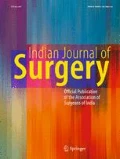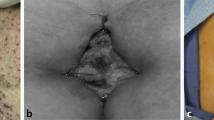Abstract
Evaluating the effect of Histoacryl on the outcome and recurrence rate after excision and primary closure of sacrococcygeal pilonidal disease. Forty patients with sacrococcygeal pilonidal sinus were randomly divided into 2 equal groups through computer randomization program. Group I was operated by complete excision of sinus with wound closure using Histoacryl. Group II was operated with primary wound closure by interrupted inverting sutures. Mean operative time was 31.5 ± 5.6 minutes in group I and 35.9 ± 5.1 minutes in group II. Mean healing time was 13.4 ± 2.7 days in group I and 18.0 ± 8.9 days in group II. Wound infection occurred in 2 patients (10%) in Group II. Delayed wound healing occurred in 3 patients (15%) in group I and 4 patients (20%) in group II. Recurrence occurred in 1 patient (5%) in group I and 3 patients (15%) in group II. Histoacryl improves outcome (significantly decreases operative and healing times and increases patient satisfaction score, insignificantly decreases rates of complications and recurrence) after excision and primary closure of sacrococcygeal pilonidal disease.



Similar content being viewed by others
References
Mayo OH (1833) Observations on injuries and disease of rectum. Burgess and Hill, London, pp 45–46 (Quoted from Da Silva JH (2000) Pilonidal cyst: cause and treatment. Dis Colon Rectum 43:1146–1156
Hodge RM (1880) Pilonidal sinus. Poston Med Surg J 103:485–6, 493, 544 (Quoted from Da Silva JH (2000) Pilonidal cyst: cause and treatment. Dis Colon Rectum 43:1146–1156
Caestecker J, Mann BD, Castellanos AE, Straus J (2006) Pilonidal Disease. http://emedicine.medscape.com/article/192668
Karydakis GE (1992) Easy and successful treatment of pilonidal sinus after explanation of its causative process. Aust NZJ Surg 62:385–389
Senapati A, Cripps NP, Thompson MR (2000) Bascom’s operation in the day-surgical management of symptomatic pilonidal sinus. Br J Surg 87:1067–1070
Ringelheim R, Silverberg MA, Villanueva NJJ (2006) Pilonidal Cyst and Sinus; http://emedicine.medscape.com/article/788127
Berger A, Frileux P (1995) Pilonidal sinus. Ann Chir 49:889–901
Binmoeller KF, Soehendra N (1999) New haemostatic techniques: histoacryl injection, banding/endoloop ligation and haemoclipping. Baillieres Best Pract Res Clin Gastroenterol 13:85–96
Von Oppell UO, Zilla P (1998) Tissue adhesives in cardiovascular surgery. J Long Term Eff Med Implants 8:87–101
Skeist I (1962) Handbook of adhesives. Reinhold Publishing corp, York
Zografos GC, Marti KC, Morris DL (1992) Laser Doppler flowmetry in evaluation of cutaneous wound blood flow using various suturing techniques. Ann Surg 215:266–268
Fotiadis C, Leventis I, Adamis S, Gorgoulis V, Domeyer P, Zografos G et al (2005) The use of isobutylcyanoacrylate as a tissue adhesive in abdominal surgery. Acta Chir Belg 105:392–396
Huskisson EC (1974) Measurement of pain. Lancet 2(7889):1127–1131
Fuzun M, Bakir H, Soylu M, Tansug T, Kaymak E, Harmancioglu O (1994) Which technique for pilonidal sinus—open or closed? Dis Colon Rectum 37:1148–1150
Iesalnieks I, Furst A, Rentsch M, Jauch KW (2003) Primary midline closure after excision of a pilonidal sinus is associated with a high recurrence rate. Chirurg 74:461–468
Khatri V, Espinosa MH, Amin AK (1994) Management of recurrent pilonidal sinus by simple V-Y fasciocutaneous flap. Dis Colon Rectum 37:1232–1235
Toccaceli S, Persico Stella L, Diana M, Dandolo R, Negro P (2008) Treatment of pilonidal sinus with primary closure. A twenty-year experience. Chir Ital 60:433–438
Tocchi A, Mazzoni G, Bononi M, Fornasari V, Miccini M, Drumo A et al (2008) Outcome of chronic pilonidal disease treatment after ambulatory plain midline excision and primary suture. Am J Surg 196:28–33
Al-Salamah SM, Hussain MI, Mirza SM (2007) Excision with or without primary closure for pilonidal sinus disease. J Pak Med Assoc 57:388–391
Søndenaa K, Diab R, Nesvik I, Petter Gullaksen F, Magne Kristiansen R, Sæbø A, Kørner H (2002) Influence of failure of primary wound healing on subsequent recurrence of pilonidal sinus. Combined prospective study and randomized controlled trial. Eur J Surg 168:614–618
Quinn J, Maw J, Ramotar K, Wenckebach G, Wells G (1997) Octylcyanoacrylate tissue adhesive versus suture wound repair in a contaminated wound model. Surgery 122:69–72
Howell JM, Bresnahan KA, Stair TO, Dhindsa HS, Edwards BA (1995) Comparison of effects of suture and cyanoacrylate tissue adhesive on bacterial counts in contaminated lacerations. Antimicrob Agents Chemother 39:559–560
Author information
Authors and Affiliations
Corresponding author
Rights and permissions
About this article
Cite this article
Othman, I. Skin Glue Improves Outcome after Excision and Primary Closure of Sacrococcygeal Pilonidal Disease. Indian J Surg 72, 470–474 (2010). https://doi.org/10.1007/s12262-010-0170-9
Received:
Accepted:
Published:
Issue Date:
DOI: https://doi.org/10.1007/s12262-010-0170-9




